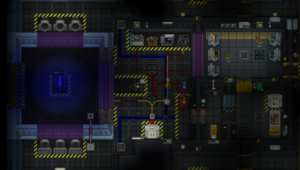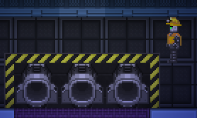Токамак R-UST: различия между версиями
imported>Rootoo мНет описания правки |
imported>Rootoo (Adds images) |
||
| Строка 7: | Строка 7: | ||
=== The Fusion Core === | === The Fusion Core === | ||
[[File:Rust room map.png|thumb|The entirety of the R-UST room and control room.]] | |||
The fusion core is the centerpiece of the R-UST, all reactions take place there and it is where the power is generated. It sits within an evacuated chamber where it cannot interact with other machinery or objects. | The fusion core is the centerpiece of the R-UST, all reactions take place there and it is where the power is generated. It sits within an evacuated chamber where it cannot interact with other machinery or objects. | ||
| Строка 14: | Строка 15: | ||
=== R-UST Control Interface === | === R-UST Control Interface === | ||
[[File:Rust control console.png|thumb|R-UST control console in an operational mode.]] | |||
The fusion core is controlled by the R-UST Mk. 8 core control console in the control room. As you can see from the image, this tracks many properties of the fusion core. | The fusion core is controlled by the R-UST Mk. 8 core control console in the control room. As you can see from the image, this tracks many properties of the fusion core. | ||
| Строка 23: | Строка 25: | ||
=== The Fuel Injectors === | === The Fuel Injectors === | ||
[[File:Rust fuel injector.png|left|thumb|The fuel injectors.]] | |||
These are used to add solid fuel into the R-UST. They are controlled using the Fuel Injection Control Computer within the control room. They must be provided with a fuel rod that can be created by putting solid fuel types into the Fuel Compressor, and then toggled on from their control computer. They will then start firing pellets through the glass into the fusion core field and be absorbed. The possible fusion fuel types will be listed below. | These are used to add solid fuel into the R-UST. They are controlled using the Fuel Injection Control Computer within the control room. They must be provided with a fuel rod that can be created by putting solid fuel types into the Fuel Compressor, and then toggled on from their control computer. They will then start firing pellets through the glass into the fusion core field and be absorbed. The possible fusion fuel types will be listed below. | ||
Версия от 02:44, 23 апреля 2023
The R-UST is an experimental fusion reactor that acts as a secondary source of power aboard the SEV Torch. It consists of a fusion core, fuel injectors, a gyrotron and a few control consoles. Fuel comes in two forms, as a fuel rod that is injected directly or by gas injection into the chamber via an injector pump. If mismanaged the R-UST can cause extreme amounts of destruction to the adjacent decks and surrounding area. The maximum output is far less than the Supermatter Engine, but it is enough to power the ship or provide a substantial boost in a pinch.
Priming, starting, and maintaining the R-UST is the job of the Engineering Department. However, some Scientists may be interested in it for research purposes.
Basic operating principles
The R-UST is about as complex as the Supermatter Engine. The basic operating principles are as follows:
The Fusion Core
The fusion core is the centerpiece of the R-UST, all reactions take place there and it is where the power is generated. It sits within an evacuated chamber where it cannot interact with other machinery or objects.
First a note on safety - The reactor will produce large quantities of radiation when operational. Ensure that you wear appropriate protective gear, even within the control room if the observation shutters are down! There is a radiation suit closet in the airlock area.
The R-UST is capable of creating a devastating EMP if operated improperly. Do not exceed the limits specified in this guide, or it will instantaneously destroy itself and make most of the crew very upset at you - If they survive. The R-UST will create this EMP when its instability reaches 100% or if it is turned off without being allowed to cool below 1000K first. Instability will be discussed below.
R-UST Control Interface
The fusion core is controlled by the R-UST Mk. 8 core control console in the control room. As you can see from the image, this tracks many properties of the fusion core.
- Power Status - This tells you the current power output and power draw of the Fusion Core. Power draw is dependent on the field strength, and power output is dependent on the fusion reactions taking place within the core.
- Field Strength - This determines the field size of the fusion core; this is important for catching fuel pellets and can be set to 20 or higher for the default R-UST configuration. Field strength must not exceed 50 tesla. If it exceeds 50 tesla then the field size will exceed that of the R-UST chamber, causing a catastrophic rise in instability and near-instantaneous destruction of the R-UST. Increasing the field strength makes the R-UST take more power, but this is negligible compared to the R-UST output when it is operating.
- Instability - Instability is raised by two things, the fusion reactions taking place and the fusion core field touching machinery or objects. It is controlled by using the Gyrotron to fire a beam of energy into the fusion core field that maintains its containment. If your instability is rising above 1% then you must immediately adjust the Gyrotron settings and/or reduce the amount of reactants being added to the field.
- Plasma temperature - This determines the reactions that can take place. Initially your fusion core will be at room temperature, and it will take some time to warm up. Once it is above a few thousand kelvin the rest of the reactions will kick in and it will keep itself stable. When turning off the fusion core this value must be below 1000K or it will cause an EMP and destruction of the R-UST containment, likely flooding Deck 2 with extremely hot gas. To cool this down stop adding reactants and turn the gyrotron power up, then wait.
- Reactants - This is a list of all current reactants in the field. Every tick of the R-UST, it will try and react these reactants together and create some radiation, instability and power based on what reactions are possible. Reactants exceeding 10,000 total reactants will be removed and turned into radiation (this is not something to worry about, just don't try to add more reactants if you are consistently hitting this threshold).
The Fuel Injectors
These are used to add solid fuel into the R-UST. They are controlled using the Fuel Injection Control Computer within the control room. They must be provided with a fuel rod that can be created by putting solid fuel types into the Fuel Compressor, and then toggled on from their control computer. They will then start firing pellets through the glass into the fusion core field and be absorbed. The possible fusion fuel types will be listed below.
The setup process
Now that you understand the important components of the R-UST, we will discuss how to set it up at the start of the shift. It is initially in a completely inoperational state.
- First, connect up each of the yellow wires. In the image of the R-UST above, you will see red wires connecting the yellow wires from the PACMAN-generator to the SMES, and from the SMES to the fusion core. These are the wires you need to add.
- The fusion core and gyrotron have a heavy power drain when operational. You will need to use the PACMAN to provide this until the fusion process becomes self-sustaining. Insert some tritium ingots from the radioactive crate and turn on the PACMAN with between 0.1MW and 0.15MW of power.
- Create five deuterium and one tritium fuel rod using the fuel compressor and insert these into the fuel injectors, one per injector.
- Return to the control room and raise the chamber containment shutters and ensure that the chamber observation is only down if you are wearing radiation protection gear.
- Set the gyrotron to fire delay 2, power 50. There can be an initial burst in instability when turning the reactor on - If you have allowed fuel to build up. So we set the gyrotron to a high-power mode for the initial startup. Do not walk infront of the gyrotron while it is active.
- Turn on the fusion core and adjust the field strength to 20 tesla.
- Turn on all the fusion fuel injectors.
- Watch the temperature and power rise on the fusion core console. Make sure that the instability is being managed by the gyrotron (less than 1%).
- Once the power output is 250kW or higher, return to the R-UST room and turn off the PACMAN-generator. It may explode if you leave it running for too long.
- You can now adjust the gyrotron power to a lower setting, such as fire delay 3, power output 3. Check that the instability is staying low after adjusting the gyrotron.
You have now set up the R-UST for a deuterium-tritium reaction, which is the simplest power-positive reaction.
The power from the R-UST will not yet reach the rest of the ship. The SMES below the control room connects the R-UST output to the rest of the ship. It starts off only able to transfer 250kW, so you will need to upgrade it by adding coils. Depending on the reactions you plan to do you will want to upgrade this to approximately 3MW maximum input/output. Wait a while for the R-UST to reach a steady self-sustaining state before you turn this on.
Emergency Shutdown Procedures
In the event that you need to shutdown the R-UST quickly follow these steps:
- Set the gyrotron to maximum power and minimum firing delay.
- Toggle the Chamber Exhaust switch, opening the R-UST chamber to space and venting any gaseous reactants.
- Turn off all fuel injectors.
- Turn on the PACMAN generator to make sure that the gyrotron keeps operating. Turn off the distribution SMES.
- Turn off the gyrotron when there are no more reactions taking place.
- The R-UST will now start to cool over time. Once it is below 1000K it can be switched off on the fusion core control console, then turn off the PACMAN.
More Power!
There are several possible fusion reactions in the R-UST and the output can be raised to approximately 2-3MW with the right setup. Not all of these reactions produce positive net power.
The setup above uses the basic deuterium-tritium reaction, which follows this path:
- Deuterium + Tritium -> Helium + 1 Power + Radiation
- Deuterium + Helium -> Nothing + 5 Power
A more productive setup involves adding hydrogen gas to the fusion core. The procedure for this is as follows:
- Allow the fusion reactor to reach >10,000K temperature with a deuterium-tritium reaction.
- Turn on the pump on the side of the fusion reactor, setting it to around 10kPA and add a full hydrogen canister.
- Turn off the tritium fuel injector now. You can replace the fuel rod in this injector with a deuterium one if you wish.
Your fusion reaction now follows this path:
- Hydrogen + Hydrogen -> Helium + 2 Power
- Deuterium + Helium -> Nothing + 5 Power
You will need to check up on the hydrogen canister and replace it occasionally, depending on the pressure you set the pump to.


